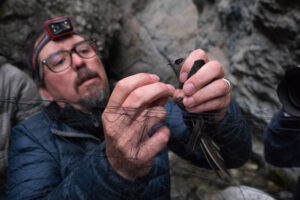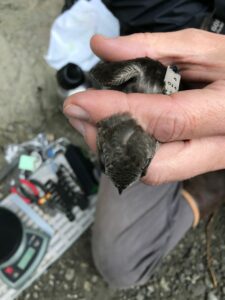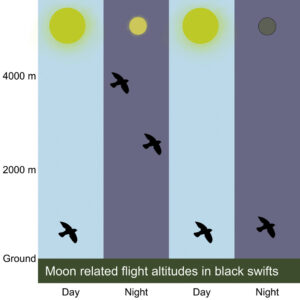NEWS RELEASE
March 28, 2022 – For Immediate Release
Contact: Rob Sparks, Spatial Ecologist-GIS Lead, (970) 482-1707 ext. 19
Bird Conservancy of the Rockies Scientists Discover Unique Flight Behavior in Black Swifts
FORT COLLINS, Colo. – Migratory birds bring joy to countless Americans every year, yet many of the birds we love are declining and disappearing due to habitat loss, climate change, and other factors. The Black Swift, a charismatic bird that breeds near waterfalls and canyons of western Colorado, is one such species. Black Swifts are masters of flight. In 2012, Bird Conservancy biologists and collaborators discovered that Black Swifts spend the non-breeding winter season in the Amazon. Black Swifts live entirely on the wing for huge periods of time, feeding on flying insects and even sleeping without ever touching down, an incredible behavior they share with their European swift relatives. Our biologists have continued to research Black Swift movement ecology to learn more about their foraging patterns and flight dynamics, all in an effort to inform the conservation of this iconic species.
To study Black Swifts, our biologists attach small data loggers to individual birds that record location, wing activity, and flight altitude to individual birds. Such information is critical to guiding conservation efforts for the species and for others who share similar habitat needs.
Using this tracking data, Bird Conservancy biologists, led by Rob Sparks and in collaboration with researchers from Lund University and Regalis Environmental LLC, have now discovered a novel behavior that has never been observed in birds before. Black Swifts regularly perform dramatic nocturnal ascents up to 13,000 ft. (4,000 m). during the full moon and surrounding nights. A lunar eclipse even triggered a synchronized descent, clearly demonstrating that moonlight has an effect on flight altitude. This previously unknown behavior could be a way for swifts to avoid predators, or the moonlight might provide a unique high-altitude foraging opportunity during times with strong moonlight that is not available during other times of the month.
These findings, recently published in the journal Current Biology, provide a new perspective on flight behavior and opens up the door to more fascinating research questions, including whether other migratory insectivores have evolved similar behaviors. Furthermore, understanding this species’ flight patterns helps us gain a more complete picture of its full annual cycle, which is necessary for successful conservation strategies. The unique aerial dynamics of this species also raise questions about the role of the aerosphere (air) in species conservation.
Funding for this work was provided by Colorado Parks and Wildlife, the Denver Field Ornithologists Research, Education and Conservation Fund, Audubon Society of Greater Denver’s Lois Webster Fund, the Swedish Research Council, and the Knut and Alice Wallenberg Foundation.
Bird Conservancy of the Rockies is a Colorado-based nonprofit that works to conserve birds and their habitats through an integrated approach of science, education and land stewardship. Our work extends from the Rockies to the Great Plains, Mexico and beyond. Together, we are improving native bird populations, the land and the lives of people. We envision a world where birds are forever abundant, contributing to healthy landscapes and inspiring human curiosity and love of nature. Visit birdconservancy.org for more information.
Accompanying images with suggested captions:
- Rob Sparks extracting a Black Swift from a mist net at Zapata Falls, Colorado. Photo: Maggie Jordan
- Black Swift with a data logger attached to its back. Photo: Rob Sparks.
- Black Swifts climb to 4,000 meters and remain At 2,000 meters during periods around the full moon, when moonlight likely allows feeding on aerial insects. A lunar eclipse catalyzed a synchronized rapid descent by the swifts, showing the direct influence of light on their behavior.
Download a PDF version of this release here.
###




